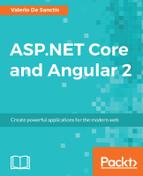What we need now is to conceive a suitable test-case scenario similar to the ones we will eventually have to deal with: a fully featured, production-ready single-page application project complete with all the core aspects you would expect from a potentially shippable product.
In order to do this, the first thing we need to do is to become our own customer for a minute and come up with an idea, a vision to share with our own other self. We'll then be able to put our developer shoes back on and split our abstract plan into a list of items we'll need to implement: these will be the core requirements of our own project. Finally, we'll set up our workstation by getting the required packages, adding the resource files, and configuring both the ASP.NET Core and Angular 2 frameworks into the Visual Studio 2015 IDE.
If we're going to demonstrate the key features of ASP.NET Core and Angular we can't really take into consideration the number of presentation-oriented websites such as demos, product galleries, corporate or marketing showcases, photo/video/media reels, and so on, as we need something that can show the asynchronous and parallel request processing capabilities of both frameworks to their full extent. In order to fulfill these expectations, we would instead need something similar to a blog engine, a content-management system, and/or a groupware platform such as a community forum or a wiki.
The latter seems to be the most appropriate, as it will mean going through a number of implementation challenges including account management, login/session handling, search-based navigation, full-text search queries, titles and contents indexing, multi-language support, markup syntax rendering, dynamic media handling and a not-so-trivial data model on top of an ever-growing, potentially huge amount of data.
The application we are going to build won't be just a shallow demonstration; we won't throw some working code here and there and expect the reader to connect the dots. Our objective is to create a solid, realistic application using our frameworks of choice while following the current development best practices. Each chapter will be dedicated to a single core aspect and if you feel like you already know your way there, feel free to skip to the next one. Conversely, if you're willing to follow us through the whole loop, you'll have a great journey through the most useful aspects of ASP.NET Core and Angular 2 and how they can work together to deliver the most common and useful web development tasks, from the most trivial ones to the more complex beasts. It's an investment that will pay dividends, as it will leave you with a maintainable, extensible, and well-structured project, plus the knowledge needed to build your own.
To avoid making things too boring, we'll pick an enjoyable, enticing theme from the entertainment industry: a collaborative, wiki-enabled database of open-source video games, where registered users will be able to add/modify entries.
We'll call it OpenGameList, also known as opengamelist.com. Luckily enough, the domain was still available at the time of writing this book. If you go there now, you'll be able to see what we're going to build from scratch (don't do that if you don't like spoilers, as it could ruin some of your fun).
Our application will follow a rather classic approach: our users will be able to browse the latest entries and navigate through the wiki using internal wiki links or via simple or complex search queries. If they're authenticated, they'll also be allowed to switch to edit mode to modify an item or add a new one, otherwise, they'll be prompted to enter their credentials via a classic login or registration form. On top of all that, we'll also add an administration area where we can do our management stuff such as deleting entries, editing/disabling/deleting users, running maintenance tasks, and so on.
Let's break down these requirements to a list of development topics:
- Routing: The app will be able to properly respond to client requests, that is to say, routing them accordingly to what they're up to.
- Data model: We'll definitely adopt a database engine to store our entries and the proper tools to access it in a modern, fashionable way. In order do so, we need to define our data architecture by setting up Data Repositories and Domain Entities that will be handled by the server and hooked to Angular 2 through ASP.NET Core's Web API controller interfaces.
- Web API controllers: From an MVC-based architectural perspective, one of the main differences between multi-page and single-page applications is that the former's controllers are designed to return views, while the latter ones, also known as API controllers, return serialized data. These are what we will need to implement to put Angular 2 components in charge of the presentation layer.
- Angular components: Switching to client-side, we will need to define a set of components to handle UI elements and state changes. As you probably already know, components are the most fundamental elements in Angular 2, replacing Angular 1's controllers and scopes. We'll get to know more about them soon enough.
- Authentication: Soon enough we'll have the need to empower our application with a membership context, that way we'll be able to restrict CRUD operations to authenticated users only, keep track of each user actions, prepare the administration layer, and so on.
These will be our main development challenges: if we don't know how to properly handle them, we won't be able to succeed.
The following chapters will address each one of them: we'll also cover other important aspects such as SEO, security, and deployment, as they will be very important when you are ready to publish your application.
